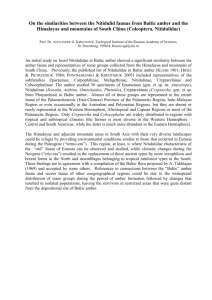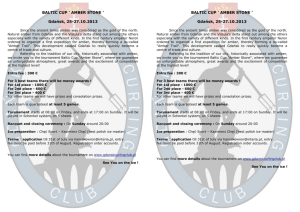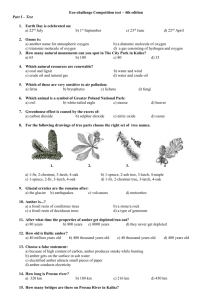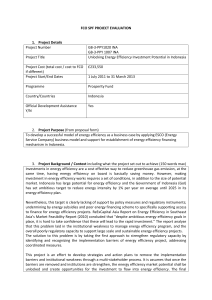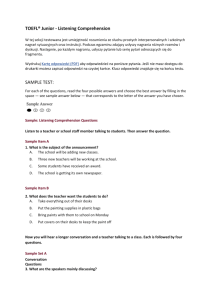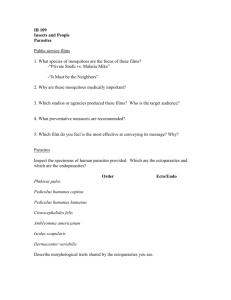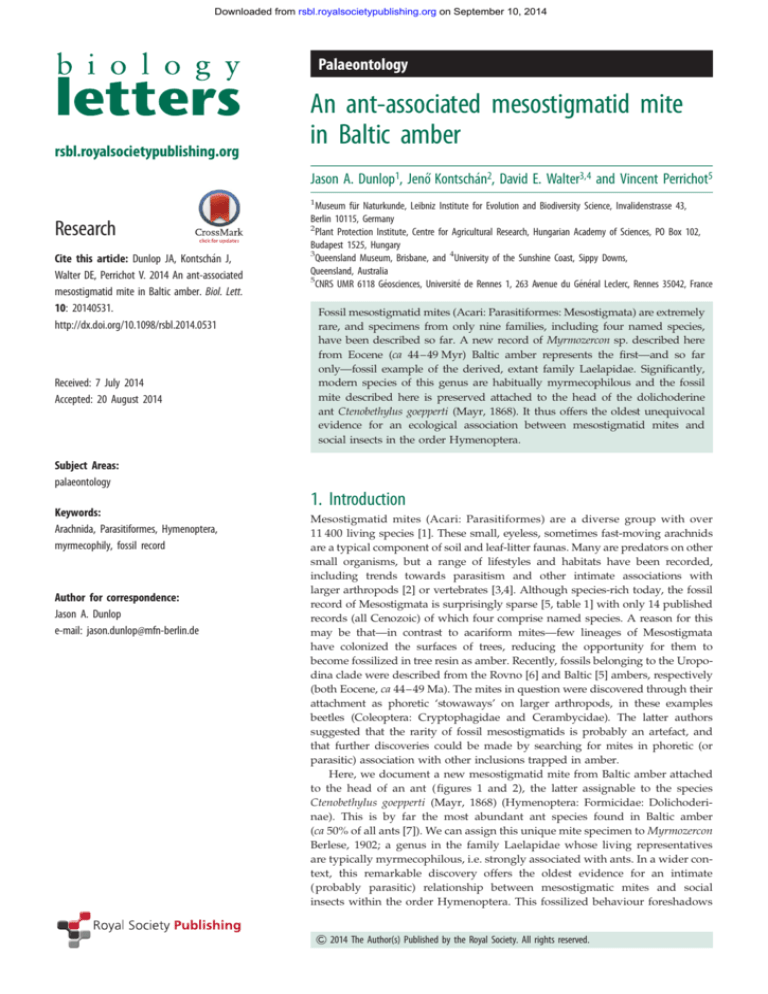
Downloaded from rsbl.royalsocietypublishing.org on September 10, 2014
Palaeontology
rsbl.royalsocietypublishing.org
An ant-associated mesostigmatid mite
in Baltic amber
Jason A. Dunlop1, Jenó´ Kontschán2, David E. Walter3,4 and Vincent Perrichot5
1
Research
Cite this article: Dunlop JA, Kontschán J,
Walter DE, Perrichot V. 2014 An ant-associated
mesostigmatid mite in Baltic amber. Biol. Lett.
10: 20140531.
http://dx.doi.org/10.1098/rsbl.2014.0531
Received: 7 July 2014
Accepted: 20 August 2014
Museum für Naturkunde, Leibniz Institute for Evolution and Biodiversity Science, Invalidenstrasse 43,
Berlin 10115, Germany
2
Plant Protection Institute, Centre for Agricultural Research, Hungarian Academy of Sciences, PO Box 102,
Budapest 1525, Hungary
3
Queensland Museum, Brisbane, and 4University of the Sunshine Coast, Sippy Downs,
Queensland, Australia
5
CNRS UMR 6118 Géosciences, Université de Rennes 1, 263 Avenue du Général Leclerc, Rennes 35042, France
Fossil mesostigmatid mites (Acari: Parasitiformes: Mesostigmata) are extremely
rare, and specimens from only nine families, including four named species,
have been described so far. A new record of Myrmozercon sp. described here
from Eocene (ca 44–49 Myr) Baltic amber represents the first—and so far
only—fossil example of the derived, extant family Laelapidae. Significantly,
modern species of this genus are habitually myrmecophilous and the fossil
mite described here is preserved attached to the head of the dolichoderine
ant Ctenobethylus goepperti (Mayr, 1868). It thus offers the oldest unequivocal
evidence for an ecological association between mesostigmatid mites and
social insects in the order Hymenoptera.
Subject Areas:
palaeontology
Keywords:
Arachnida, Parasitiformes, Hymenoptera,
myrmecophily, fossil record
Author for correspondence:
Jason A. Dunlop
e-mail: jason.dunlop@mfn-berlin.de
1. Introduction
Mesostigmatid mites (Acari: Parasitiformes) are a diverse group with over
11 400 living species [1]. These small, eyeless, sometimes fast-moving arachnids
are a typical component of soil and leaf-litter faunas. Many are predators on other
small organisms, but a range of lifestyles and habitats have been recorded,
including trends towards parasitism and other intimate associations with
larger arthropods [2] or vertebrates [3,4]. Although species-rich today, the fossil
record of Mesostigmata is surprisingly sparse [5, table 1] with only 14 published
records (all Cenozoic) of which four comprise named species. A reason for this
may be that—in contrast to acariform mites—few lineages of Mesostigmata
have colonized the surfaces of trees, reducing the opportunity for them to
become fossilized in tree resin as amber. Recently, fossils belonging to the Uropodina clade were described from the Rovno [6] and Baltic [5] ambers, respectively
(both Eocene, ca 44–49 Ma). The mites in question were discovered through their
attachment as phoretic ‘stowaways’ on larger arthropods, in these examples
beetles (Coleoptera: Cryptophagidae and Cerambycidae). The latter authors
suggested that the rarity of fossil mesostigmatids is probably an artefact, and
that further discoveries could be made by searching for mites in phoretic (or
parasitic) association with other inclusions trapped in amber.
Here, we document a new mesostigmatid mite from Baltic amber attached
to the head of an ant (figures 1 and 2), the latter assignable to the species
Ctenobethylus goepperti (Mayr, 1868) (Hymenoptera: Formicidae: Dolichoderinae). This is by far the most abundant ant species found in Baltic amber
(ca 50% of all ants [7]). We can assign this unique mite specimen to Myrmozercon
Berlese, 1902; a genus in the family Laelapidae whose living representatives
are typically myrmecophilous, i.e. strongly associated with ants. In a wider context, this remarkable discovery offers the oldest evidence for an intimate
( probably parasitic) relationship between mesostigmatic mites and social
insects within the order Hymenoptera. This fossilized behaviour foreshadows
& 2014 The Author(s) Published by the Royal Society. All rights reserved.
Downloaded from rsbl.royalsocietypublishing.org on September 10, 2014
(a)
(b)
2
ant
Figure 1. F2534/BB/CJW, Myrmozercon sp. (Mesostigmata: Laelapidae) from Eocene Baltic amber attached to the dolichoderine ant Ctenobethylus goepperti (Mayr,
1868). (a) Overview. (b) Interpretative drawing. (Online version in colour.)
the emergence of other species that attack hymenopterans;
such as Tropilaelaps clareae Delfinado and Baker, 1961 (Laelapidae) or Varroa destructor Anderson & Trueman, 2000 from
the closely related family Varroidae—mites that are of
commercial importance today as pests of honeybees [8,9].
2. Material and methods
The new amber specimen derives from the Jörg Wunderlich
collection and bears the repository number F2534/BB/CJW. It
will be transferred at a later date to the Senckenberg Institute Frankfurt/Main or one of its satellite institutions (J. Wunderlich 2012,
personal communication). The ant and mite are preserved in a
thin, rectangular piece of clear yellow amber with dimensions of
ca 20 14 mm. A bubble partially obscures the ventral surface of
the mite. A precise locality for the specimen is not available, but
much of the recently collected Baltic amber stems from the Kaliningrad region of the Russian Baltic coast. Baltic amber is thought to
have been deposited in a warm forest environment and is conventionally dated at Eocene (Lutetian), or about 44–49 Ma, but could
be slightly younger [10]. For a recent overview of this amber deposit
and its geological setting, see Weitschat & Wichard [11]. Specimens
were studied and drawn under a Leica stereomicroscope and Zeiss
Axioscope compound microscope, both with a camera lucida
attachment. The specimens were photographed via the LEICA APPLICATION SUITE software which enabled stacks of images at various
focal depths to be combined into a final picture.
3. Systematic palaeontology
Parasitiformes Reuter, 1909
Mesostigmata Canestrini, 1891
Monogynaspida Camin & Gorirossi, 1955
Gamasina Kramer, 1881
Dermanyssiae Evans & Till, 1979
Dermanyssoidea Kolenati, 1859
Laelapidae Berlese, 1892
Genus Myrmozercon Berlese, 1902
¼ Myrmonyssyus Berlese, 1903
¼ Parabisternalis Ueckermann & Loots, 1995
(a) Material
F2534/BB/CJW. Baltic amber. Palaeogene: Eocene: Lutetian.
(b) Description
Dorsal idiosoma convex, rounded to oval in outline (length
700 mm; width 650 mm); holodorsal shield present. Surface of
holodorsal shield smooth; some wrinkles visible, but larger
and deeper sculptural pattern not visible. Long dorsal setae
not visible; probable dorsal setae short, particularly around
posterior idiosomal margin, and hypertrichous. Sternal, genital and most of ventral region obscured but subtriangular
anal shield visible. All legs short, stubby (lengths ca 420 mm
or less, leg IV notably smaller), terminating in fan-shaped pulvillus; tarsus I ca 2 length tibia I. Gnathosoma ca 240 mm long
(in ventral view); chelicerae equivocal, but palp distinct, short
(100 mm), linear, tarsus obscure.
(c) Remarks
Unfortunately, important characters for differentiating known
Myrmozercon such as the details of the dorsal shield, sternal
and genital shields and their setation, and the chelicerae are
not visible in the fossil specimen and preclude meaningful comparisons with living species. However, our knowledge of extant
species of Mesostigmata that live on ants strongly supports the
assignment of this fossil to Myrmozercon. Particular characters
that support this assignment include: the similar body shape
and size; stubby legs with mostly short, broad segments; all
tarsi with well-developed, pad-like ambulacra; anal shield,
and the palpal tibia apparently encompassing the tarsus
(figure 2a–f). Ant-associated antennophorine Mesostigmata
(Aenictequoidea, Anennophoroidea) also exhibit hypertrichy,
but lack ambulacra on legs I and differ from this fossil in
many other details. Other gamasine ant-associates also differ
in general habitus and in particular characters including
having ambulacra with strong claws, a well-developed palpal
tarsus, and lacking extensive hypertrichy.
Type species. Myrmozercon brevipes Berlese, 1902.
4. Discussion
Myrmozercon sp.
Figures 1 and 2a–d.
For recent accounts of Myrmozercon, including a redescription of
the type species, see [12–16]. Living representatives of this genus
Biol. Lett. 10: 20140531
1 mm
rsbl.royalsocietypublishing.org
mite
Downloaded from rsbl.royalsocietypublishing.org on September 10, 2014
3
(b)
(a)
rsbl.royalsocietypublishing.org
(d )
as
ds
ds
id
200 mm
hs
bubble
IV
IV
gn
III
pv
II
III
I
pp
I
II
pv
(e)
(f)
IV
III
III
II
I
II
I
Figure 2. Details of the fossil mite in (a) dorsal view and (b) ventral view, together with respective interpretative drawings (c,d) and comparative dorso-ventral images (e,f ) of
the living species Myrmozercon brevipes Berlese, 1902. as, anal shield; ds, dorsal setae; gn, gnathosoma; hs, holodorsal shield; id, idiosoma; pp, pedipalp; pv, pulvillus; legs
numbered I–IV. (Online version in colour.)
are true myrmecophiles. They are typically found in ant nests or
on worker or alate ants where they are thought to be parasitic,
rather than commensal, although this has not yet been demonstrated experimentally [13]. Twenty-four extant species of
Myrmozercon—many originally described under the junior synonym Myrmonyssyus Berlese, 1903—are known, mostly from a
single species of ant host (see comments in [13]). Some associations are unknown; M. robustisetae was described from a
termite nest [16] but appears to be misplaced in the genus Myrmozercon [15]. Previous associations have been reported from a
wide variety of ant genera in three subfamilies: Dolichoderinae
(Iridomyrmex, Tapinoma); Formicinae (Camponotus, Myrmecocystus, Polyrhachis); Myrmicinae (Aphenogaster, Crematogaster,
Messor, Tetramorium). Extant species of Myrmozercon with
dense hypertrichy are associated with the dolichoderine
genera Iridomyrmex and Tapinoma. Interestingly, the Baltic
amber ant Ctenobethylus is very similar to Iridomyrmex, such
that it was synonymized under this modern genus for 20 years
before being re-instated as a distinct, extinct genus [17].
Our present discovery of a Myrmozercon mite in amber
attached to an ant is significant for a number of reasons. It
represents the first—and so far only—example of the derived
mesostigmatid family Laelapidae, and its superfamily Dermanyssoidea, in the fossil record. Second, there has only
been one other published record of ants in amber being parasitized by mites. Wheeler mentioned workers of the formicine
Lasius schiefferdeckeri Mayr, 1868 with ‘gamasid’ (¼ mesostigmatid) mites attached to their hind tibiae [18, pp. 21–22].
Biol. Lett. 10: 20140531
(c)
Downloaded from rsbl.royalsocietypublishing.org on September 10, 2014
Acknowledgement. We thank Jörg Wunderlich (Hirschberg) for making
material from his collection available and Ise Schmitz-Kössendrup
(Berlin) and the reviewers for helpful comments.
References
1.
2.
3.
4.
5.
6.
Beaulieu F, Dowling APG, Klompen H, de Moraes GJ,
Walter DE. 2011 Superorder Parasitiformes Reuter,
1909. In Animal biodiversity: an outline of higherlevel classification and survey of taxonomic richness
(ed Z-Q Zhang). Zootaxa 3148, 123–128.
Hunter PE, Rosario RMT. 1988 Associations of
Mesostigmata with other arthropods. Annu. Rev.
Entomol. 33, 393–417. (doi:10.1146/annurev.en.33.
010188.002141)
Walter DE, Proctor HC. 1999 Mites. Ecology, evolution
and behaviour. Wallingford, UK: CABI Publishing.
Lindquist EE, Krantz GW, Walter DE. 2009 Order
Mesostigmata. In A manual of acarology (eds
GW Krantz, DE Walter), pp. 124 –231, 3rd edn.
Lubbock, TZ: Texas Tech University Press.
Dunlop JA, Kontschán J, Zwanzig M. 2013 Fossil
mesostigmatid mites (Mesostigmata: Gamasina,
Microgyniina, Uropodina), associated with longhorn
beetles (Coleoptera: Cerambycidae) in Baltic amber.
Naturwissenschaften 100, 337 –344. (doi:10.1007/
s00114-013-1031-8)
Lyubarsky GY, Perkovsky EE. 2012 The first Eocene
species of the genus Cryptophagus (Coleoptera,
Clavicornia, Cryptophagidae). Vest. Zool. 46, e36–
e40. (doi:10.2478/v10058-012-0007-z)
7.
8.
9.
10.
11.
12.
13.
Dlussky GM, Rasnitsyn AP. 2009 Ants (Insecta:
Vespida: Formicidae) in the Upper Eocene amber
of Central and Eastern Europe. Paleontol. J. 43,
1024 –1042. (doi:10.1134/S0031030109090056)
Sammataro D, Gerson U, Needham G. 2000 Parasitic
mites of honey bees: life history, implications and
impact. Ann. Rev. Entomol. 45, 519 –548. (doi:10.
1146/annurev.ento.45.1.519)
Rosenkranz P, Aumeier P, Ziegelmann B. 2010
Biology and control of Varroa destructor. J. Invert.
Pathol. 103, 96–119. (doi:10.1016/j.jip.2009.07.016)
Standke G. 1998 Die Tertiärprofile der
Samländischen Bernsteinküste bei Rauschen. Schrift.
Geowiss. 7, 93 –133.
Weitschat W, Wichard W. 2010 Baltic amber. In
Biodiversity of fossils in amber from the major world
deposits (ed. D Penney), pp. 80 –115. Manchester,
UK: Siri Scientific Press.
Walter DE. 2003 A new mite from an arboreal ant
(Formicidae: Polyrhachis sp.): Myrmozercon iainkayi
n. sp. (Mesostigmata: Laelapidae). Int. J. Acarol. 29,
81 –85. (doi:10.1080/01647950308684325)
Shaw MD, Seeman OD. 2009 Two new species of
Myrmozercon (Acari: Laelapidae) from Australian ants
(Hymenoptera: Formicidae). Zootaxa 2025, 43–55.
14. Ghafarian A, Joharchi O, Jalalizand A, Jalaeian M.
2013 A new species of Myrmozercon Berlese (Acari,
Mesostigmata, Laelapidae) associated with ant from
Iran. ZooKeys 272, 21 –28. (doi:10.3897/zookeys.
272.4404)
15. Joharchi O, Moradi M. 2013 Review of the genus
Myrmozercon Berlese (Acari: Laelapidae), with
description of two new species from Iran. Zootaxa
3686, 244–254. (doi:10.11646/zootaxa.3686.2.6)
16. Rosario RMT, Hunter PE. 1988 The genus
Myrmozercon Berlese, with descriptions of two new
species (Acari: Mesostigmata: Laelapidae).
J. Parasitol. 74, 466 –470. (doi:10.2307/3282057)
17. Dlussky GM. 1997 Genera of ants (Hymenoptera:
Formicidae) from Baltic amber. Paleontol. J. 31,
616–627.
18. Wheeler WM. 1915 The ants of the Baltic
amber. Schrift. Phys. Ökonom. Ges. Königsberg 55,
1–142.
19. Eickwort GC. 1990 Associations of mites with social
insects. Ann. Rev. Entomol. 35, 469–488. (doi:10.
1146/annurev.en.35.010190.002345)
20. Elzinga RJ. 1982 The genus Antennequesoma (Acari:
Uropodina) and descriptions of four new species.
Acarologia 23, 319–325.
4
Biol. Lett. 10: 20140531
As in our amber piece, living Myrmozercon species can
sometimes be found attached to the head of their ant host
[15]; a specific behaviour that we can now trace back to at
least the Eocene. The high host specificity noted above—i.e.
one Myrmozercon species typically attaches itself to only one
ant species—may be important if other fossil ants are discovered carrying mesostigmatids, the prediction being that
different amber ants should host different Myrmozercon
species. The high frequency of Ctenobethylus among all Baltic
amber ant specimens may allow for a more precise survey of
this specific association with Myrmozercon. As mentioned
above, amber, being fossilized tree resin, tends to trap arboreal
faunal elements more often than ground-dwelling ones, and
there is at least one case of a modern Myrmozercon species
being associated with an arboreal ant [12]. A number of
living species from other genera of the family Laelapidae can
also be found on ants [15], and our research further shows
that it may be worth checking specimens of other social insects
preserved in amber for associated (parasitiform) mite
inclusions. It is conceivable that we shall be able to recover
further palaeontological data documenting the origins and
evolution of these important host–parasite relationships.
rsbl.royalsocietypublishing.org
That said, his original (fig. 58) drawing evidently shows a
larval parasitengonid mite; an acariform group that are commonly discovered parasitizing other amber arthropods.
Third, in modern ecosystems, there is considerable interest
in those Mesostigmata that attack social insects [19] and, in
particular, honeybees (see above). We demonstrate here
that, at least for ants, ecological relationships of this nature
can be traced back almost 50 Myr.
Indeed, various types of association between mesostigmatid mites and ants have been recorded in the literature. In some
of these, mites express explicit morphological adaptations.
A good example would be the ‘holdfast’ mechanism in the
Trichocylliba subgenera (Acari: Uropodina), within which
different degrees of adaptation can be observed. The genus
Circocylliba has only very strong claws to attach itself to the
ant’s body. By contrast, in the other subgenera (Coxequesoma
and Antennequesoma), the idiosoma margin is curved and
helps attach the mites to the legs or the antenna (see [20]
and references therein). Other types of ant association involve
mites—such as our Myrmozercon here—in which specific morphological adaptations are not apparent, and the mite simply
holds itself in place using its legs. Myrmozercon also lacks
claws on the legs and has instead a suction-like pulvillus,
also visible in the fossil (figure 2d, pv), but these features are
not unique to this genus and can be found in other mites
living on insects as well.

